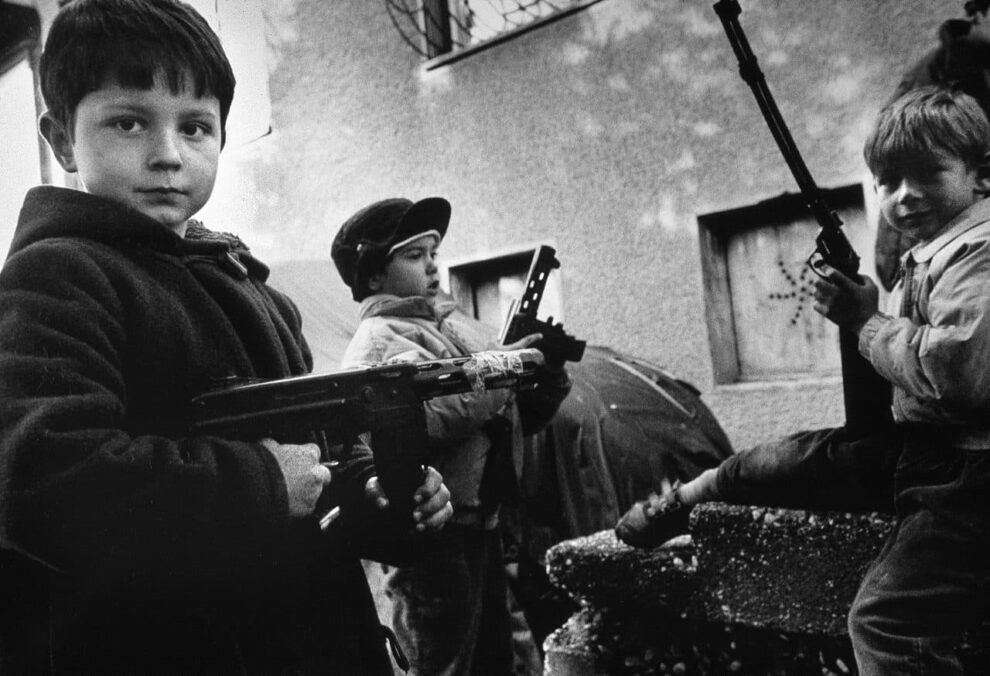In the final instalment of BIRN’s war photography series, Debbi Morello recalls her year in besieged Sarajevo, where snipers were an ever-present threat and casualties were buried in the stadium where Olympic events had been held.
“I just really wanted to document history,” American photographer Debbi Morello tells BIRN from her home in Washington DC.
At the beginning of the 1990s, when Morello was starting her career in photography, a lot of history was being made. The First Gulf War was being fought, East and West Germany had just reunited and Yugoslavia was falling apart.
Morello had a history degree and a taste for travel. She decided to become a photojournalist at the age of 37, and was in Italy when the war in Croatia broke out.
“I just could not believe what was happening there, it was not a Third World country, it was in Europe, and I just knew I needed to be there,” she said.
In 1993, she arrived in Bosnia and Herzegovina and travelled to Mostar, a city divided by the Neretva river, which had become the frontline in fighting between the Croat-led Croatian Defence Council, HVO, and the Bosniak-led Army of Bosnia and Herzegovina.
“I arrived there when the UN humanitarian convoy was held hostage. Soon after, some truce was made and the convoy was released,” Morello remembered.
The UN convoy carrying medicines had reached Mostar on August 21, 1993 after nearly two months of obstruction from Bosnian Croat forces, but took five more days to reach the Muslim quarter in the east of the city.
After the convoy got through, local Bosniaks initially prevented the UN personnel from leaving again in order to deter the HVO from shelling. On August 28, they were allowed to depart, but only after Spanish soldiers agreed to stay in the Muslim-controlled sector of the city to deter further attacks by the Bosnian Croats.
This was the day that Morello got to Mostar. “That day, a few journalists were allowed to travel with the UN into East Mostar to ensure the departure of the detained convoy. I travelled with them,” she said.
After Mostar, her next destination was the besieged capital Sarajevo, where she witnessed more history in the making.
‘I could feel the snipers watching’

Morello recalls the year she lived in Sarajevo in 1993 as the best of the subsequent 15 years she spent documenting wars and conflict zones around the world.
Bosnia’s capital city was besieged by Bosnian Serb forces from 1992 until February 1996. During that time, some 14,000 people were killed.
Morello was living in the Ciglane neighbourhood, close to the iconic Zetra Olympic Hall, which hosted some of the 1984 Winter Olympics events in Sarajevo, and which was occasionally subjected to sniper fire during the siege.
“I stayed there for a year, and I remember feeling like the snipers were constantly watching me through my window,” she recalled.
One of the photographs she remembers best from her time in Sarajevo was her image of a mother burying her son in what was once the Olympic Stadium in the nearby Kosevo neighbourhood.
“Just eight years [after Sarajevo hosted the Winter Olympics], the city became the deadliest city in the war for Bosnian independence. The former Olympic venue became a crowded graveyard filled with the dead from the war,” she said.
Professionals and ‘war tourists’

In the 15 years after she covered the siege of Sarajevo and the Bosnian war, Morello went on to cover the conflict in Chechnya, based herself in Haiti and in Africa, where she reported from Rwanda, Zaire, Uganda, Kenya and Sudan, and worked in Iraq and Afghanistan.
She has freelanced for the New York Times and the Washington Post, as well as Life, Time and Newsweek magazines, and said that during her time reporting from conflicts and crisis zones, she had to learn who to trust while on assignments.
“I think that since the beginning I had a good sense for recognising professionals from war tourists who came to document things for their own interest,” she said.
Nevertheless, even when she surrounded herself with professionals, mistakes were inevitably made. In 1994, she was travelling with a group of journalists from Sarajevo to Jablanica and had to cross several checkpoints on the way.
“At one of the checkpoints, I took my camera out without thinking too much, and I took a photo of a Serb military officer,” she said.
“They immediately started screaming at us, and I had to take my film roll from the camera and give it to them,” she remembered, laughing.
Morello decided to retire from journalism in 2014 and subsequently taught English as her source of income. Even before her retirement, she was only taking short-term photographic assignments in the US.
“I felt like I had enough,” she said. So far, she has never been back to Bosnia and Herzegovina since her last assignment there, but admitted that she often thinks about the consequences of the war for the country and its people, and now has plans to finally return.
“I’m moving to Italy soon, and I’m planning to do a road trip to visit all the places and people I’ve seen during the war,” she said.
“And I can’t wait to have a Bosnian coffee, which kept me going through so many war days.”
Source : Balkan Insight





Add Comment